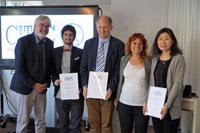 |
| Credit: Enrico Massa and Carlo Sasso |
Neutron activation scientist Attila Stopic and Dr John Bennett, Leader Radioisotopes and Radiotracing/Radiobiology and Bioimaging, are among the authors of paper selected by the international group, Cooperation on International Traceability in Analytical Chemistry (CITAC), as the Best Paper in 2017.
The paper, “Measurement of the 30Si Mole Fraction in the New Avogadro Silicon Material by Neutron Activation and High Resolution γ-Spectrometry” was published in Analytical Chemistry.
The research was led by Dr Marco Di Luzio of the Instituto Nazionale di Recerca Metrologica (Italy) with other contributors from the University of Pavia, the National Metrology Institute of Germany and ANSTO.
At a ceremony in Paris, Di Luzio accepted the award and gave a presentation about his group’s contribution to the seminal work on redefining the fundamental measurement of the kilogram in terms of a universal constant.
 |
| Paper authors accept award in Paris. John Bennett and Attila Stopic were unable to attend |
He outlined the group’s experiments to determine the number of atoms in a single crystal of silicon-28 (28Si) in the form of a highly polished and extremely round sphere by measuring the volume of the atomic unit cell and the overall volume of the sphere.
A more precise definition of Avogadro's number (the number of atoms or molecules in one mole of a substance) strengthens the definition of Planck's constant, the value that will set the size of the kilogram in the revised standard of measurement.
Di Luzio travelled to ANSTO to undertake neutron activation analysis in the OPAL reactor, which provided crucial isotopic information about the new generation silicon for the measurements.
The high neutron flux in the OPAL reactor was used to irradiate a silicon crystal enriched in 28Si and an identically manufactured natural silicon crystal used as a reference standard. The irradiations, which activate elements present in the sample, enabled the researchers to use gamma spectrometry to measure the isotopic masses in the silicon.
The investigators measured the depletion of 30Si in the enriched 28Si crystal, which contributed to the level of uncertainty in determining the molar mass.
Uncertainly requirements have been set by the Bureau International des Poids et Mesures (BIPM) before redefinition can occur. Other conditions to be met include consistence, traceability and validation.
The investigation was undertaken to resolve a discrepancy in evaluation of mole fractions obtained with previous measurements of enriched 28Si using isotope dilution mass spectrometry.
Di Luzio reported that mole fraction measurements of 30Si were initially trialed with instrumental neutron activation analysis using a lower-powered reactor at the University of Pavia.
The neutron activation analysis at ANSTO on the 30Si was applied to achieve the minimum possible uncertainty on the 30Si measurement.
In order to activate the trace amounts of silicon isotopes, the sample was loaded into a high flux area of the reactor.
It also required prompt handling to ensure counting occurred before the short lived isotope decayed in a few hours.
“The most sensitive gamma spectrometry instrument at ANSTO, which is held by the Nuclear Stewardship group, was used for the measurements,” said Stopic.
There were two other papers published by the group associated with the research. A study on the impurities in 28Si in Analytical Chemistry and a paper on counting the atoms in enriched silicon using X-ray crystallography to determine Avogadro’s constant in Metrologia.
World Metrology Day 20 May 2018
The theme for World Metrology Day 2018 is Constant evolution of the International System of Units. This theme was chosen because in November 2018, the General Conference on Weights and Measures is expected to agree one of the largest changes to the International System of Units (the SI) since its inception.
The BIPM is expected to adopt the new definition of the kilogram at a general conference in November this year and end the linkage to a physical artefact.
In future the kilogram will be defined in terms of the Planck constant, guaranteeing long term stability of the standard unit of measurement.
The BIPM has announced that the new definition opens up the possibility of national measurement institutes developing their own realisations of the kilogram using a Kibble balance or X-ray crystal density experiments.
The realisation of the kilogram means the establishment of the value and associated uncertainty of a quantity of the same kind as the unit that is consistent with the unit.
The proposed definition of the kilogram SI base unit of mass is:
The kilogram, symbol kg, is the SI unit of mass. It is defined as taking the fixed numerical value of the Planck constant h to be 6.626 070 15 x 10-34 when expressed in the unit J s, which is equal to kg m2 s-1, where the metre and the second are defined in terms of c and
∆vCs.
More information is available on the BIPM website.
Published: 16/05/2018



